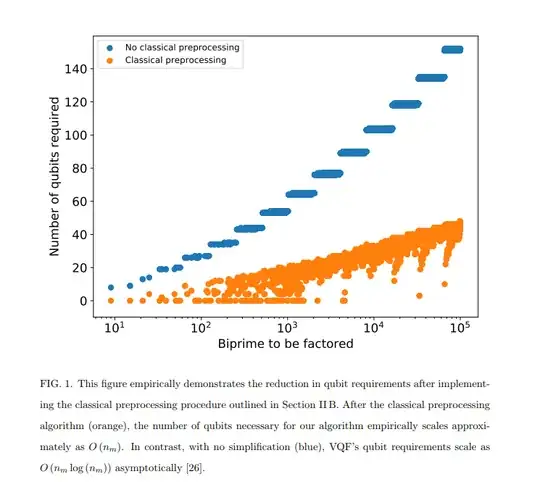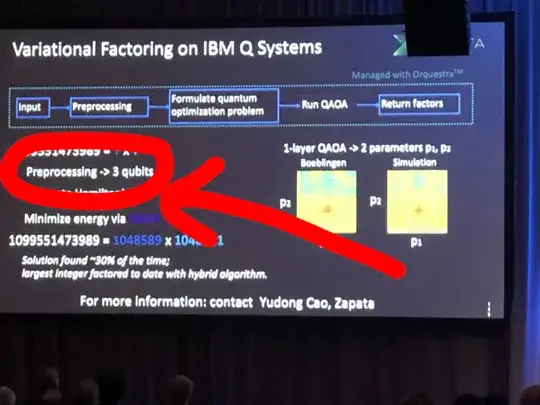The claimed new quantum factoring record is $n=a(a+b)$ with $a=1048589=2^{20}+13$ and $b=12$. It could well be that the form $n=a(a+b)$ with $0\le b\le12$ (or other small upper bound for $b$) defines all the sizable numbers the new record-claiming method can factor (with the indicated $3$ qubits on the hardware at hand and the ∼30% success rate, based on the picture in that answer). Such $n$ are scarce: their proportion near $n$ thins out as $6.5/\sqrt n+\mathcal o(1/\sqrt n)$ [*]. The method lacks generality.
Further, the factor $a$ of such $n$ is effortlessly found using Fermat's factorization method (exposed in a fragment of letter likely to Mersenne circa 1643). If $n=a(a+b)$ with $0\le b\le2\sqrt a$ (a much larger class of integers), only the first step of Fermat's factoring is required (for all except very small $n$): compute $r=\bigl\lceil\sqrt{4n}\,\bigr\rceil$, then $a=(r-\sqrt{r^2-4n})/2$. That's enough to factor 1099551473989 by hand.
The picture and that other answer refer to Eric R. Anschuetz, Jonathan P. Olson, Alán Aspuru-Guzik, Yudong Cao's Variational Quantum Factoring (arXiv:808.08927, Aug 2018). That reduces factorization to a combinatorial problem with number of unknowns proportional to the bit length of the factors. I find nothing suggesting the preprocessing makes that sublinear in the general case, and conclude that Variational Quantum Factoring is exponential in the bit length of $n$, thus essentially pointless since we have sub-exponential algorithms for factorization on classical computers.
Similar stunts of stretching to artificially large numbers what an experimental setup allows have already been pulled. Take the record of 143=11×13 by Nanyang Xu, Jing Zhu, Dawei Lu, Xianyi Zhou, Xinhua Peng, and Jiangfeng Du in Quantum Factorization of 143 on a Dipolar-Coupling Nuclear Magnetic Resonance System (Physical Review Letters, 2012). Their experimental technique factors an integer product of two odd exactly-4-bit integers (thus with two unknown bits per factor). The scarcity of primes in range [8,15] makes 143 the only product of two distinct primes that the technique can factor. Their experimental setup iteratively minimizes a function with a 2-bit input. This achievement (I'm not joking up to this point) has been stretched, without new experiment AFAIK, to:
- 56153=233×241 by Nikesh S. Dattani and Nathaniel Bryans, Quantum factorization of 56153 with only 4 qubits (arXiv:1411.6758, 2014)
- 4088459=2017×2027, by Avinash Dash, Deepankar Sarmah, Bikash K. Behera, and Prasanta K. Panigrahi, Exact search algorithm to factorize large biprimes and a triprime on IBM quantum computer (arXiv:1805.10478, May 2018)
- 383123885216472214589586724601136274484797633168671371=618970019642690137449562081×618970019642690137449562091 by myself (crypto.SE, June 2018), using the technique of the above paper.
[*] Proof: for each $a$, there are $13$ values of $b$ leading to $13$ values of $n$ of the form $n=a(a+b)$ with $0\le b\le12$. For large enough $a$ there are no two $(a,b)$ leading to the same $n$[#]. When we increase $n$ by $1$, $n^2$ increases by $2n+1$. Taking the inverse, the density of squares near large $n$ is $\displaystyle\frac1{2\sqrt n}+\mathcal o(\sqrt n)$. Thus the density of $n$ of the form $a(a+b)$ with $0\le b\le12$ is $\displaystyle\frac{13}{2\sqrt n}+\mathcal o(1/\sqrt n)$.
[#] Auxiliary proof: Assume $a(a+b)=a'(a'+b')$ with $0\le b\le12$ and $0\le b'\le12$. Let $c=2a-b$ and $c'=2a'-b'$. It comes $(c-b)(c+b)/4=(c'-b')(c'+b')/4$, thus $c^2-b^2=c'^2-b'^2$, thus $c^2-c'^2=b^2-b'^2$, thus $|(c-c')(c+c')|\le144$, thus for $c\ge72$ and $c'\ge72$ the only solution is $c=c'$, hence $b=b'$. Thus for $a\ge42$ and $a'\ge42$ the only solution is $a=a'$ and $b=b'$. The bound on $a$ can be further lowered.

